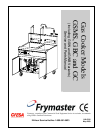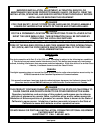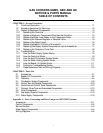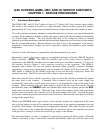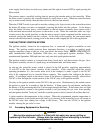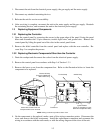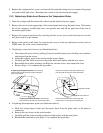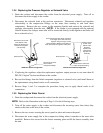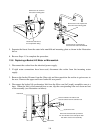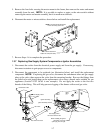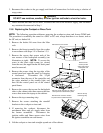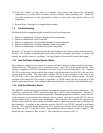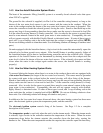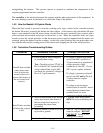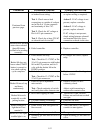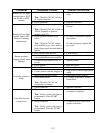
1-2
water supply line for three seconds every minute until the option is turned OFF by again pressing the
Skim switch.
The operator enters a specified cooking time by pressing the number pads on the controller. When
the Start switch is pressed, the controller begins to count down to zero. When the controller times
out, an alarm sounds briefly, then the timer reverts to the last time entered.
When the START switch is pressed to start the cooking cycle, logic circuits in the controller activate
the basket lift motors (on units so equipped), lowering the basket into the cookpot. As the motors
drive the basket lift arms down, a cam attached to the left motor eventually loses contact with a
roller-activated microswitch and power to the motors is cut. When the controller times out, logic
circuits reverse the switch positions so that the motor circuit is again completed and the motors are
restarted, raising the basket from the cookpot. At the fully raised position, the cam again makes
contact with the microswitch, cutting power to the motors and stopping the lift in the up position.
THE ELECTRONIC IGNITION SYSTEM
The ignition module, located in the component box, is connected to ignitor assemblies at each
burner. The ignition module performs three important functions: it provides an ignition spark,
supplies operating voltage to the gas valve, and proofs the burner flame. NOTE: GSMS/GBC/GC
units manufactured before September 2000 have two single-spark ignition modules. Those
manufactured September 2000 and later have only one dual-spark ignition module.
The ignition module contains a 4-second time delay circuit and a coil that activates the gas valve.
The ignitor assembly consists of a spark plug, an enrichment tube, and flame sensor.
At start-up, the controller power switch is placed in the ON position, supplying approximately
12-volts DC to the heat control circuitry in the controller. If the controller senses the correct
operating parameters (i.e., the correct water level in the cookpot), it sends a signal to the 24VAC
relay in the component box to close the blower contacts. This supplies line voltage to the blower
motor. A centrifugal switch in the blower closes if the blower is operating correctly, which allows
24VAC to flow through the closed contacts of the 24VAC relay to the ignition module.
Circuitry in the ignition modules sends 24VAC to the gas valve. Simultaneously, the module causes
the ignitors to spark for 4 seconds to light the burners. A flame sensor for each burner verifies that
the burner is lit by measuring the flow of microamps through the flame. If the burner does not light
(or is extinguished), current to the ignition module is cut, preventing the gas valve from opening,
and the ignition module “locks out” until the controller power switch is turned off and then back on.
A probe monitors the temperature in the cookpot. When the programmed setpoint temperature is
reached, resistance in the probe causes the heat cycle circuitry in the controller to cut off current to
the 24VAC relay, thus cutting line voltage to the blower. This cuts the 24VAC to the ignition
module, causing the gas valve to close.
1.2 Accessing Equipment for Servicing
DANGER
Moving this equipment while it is filled with hot water may cause spilling or
splattering of the hot water. Always drain the cookpot before attempting to relocate
this equipment for servicing.



